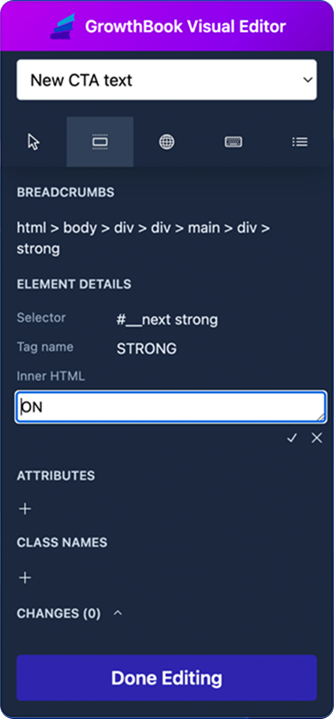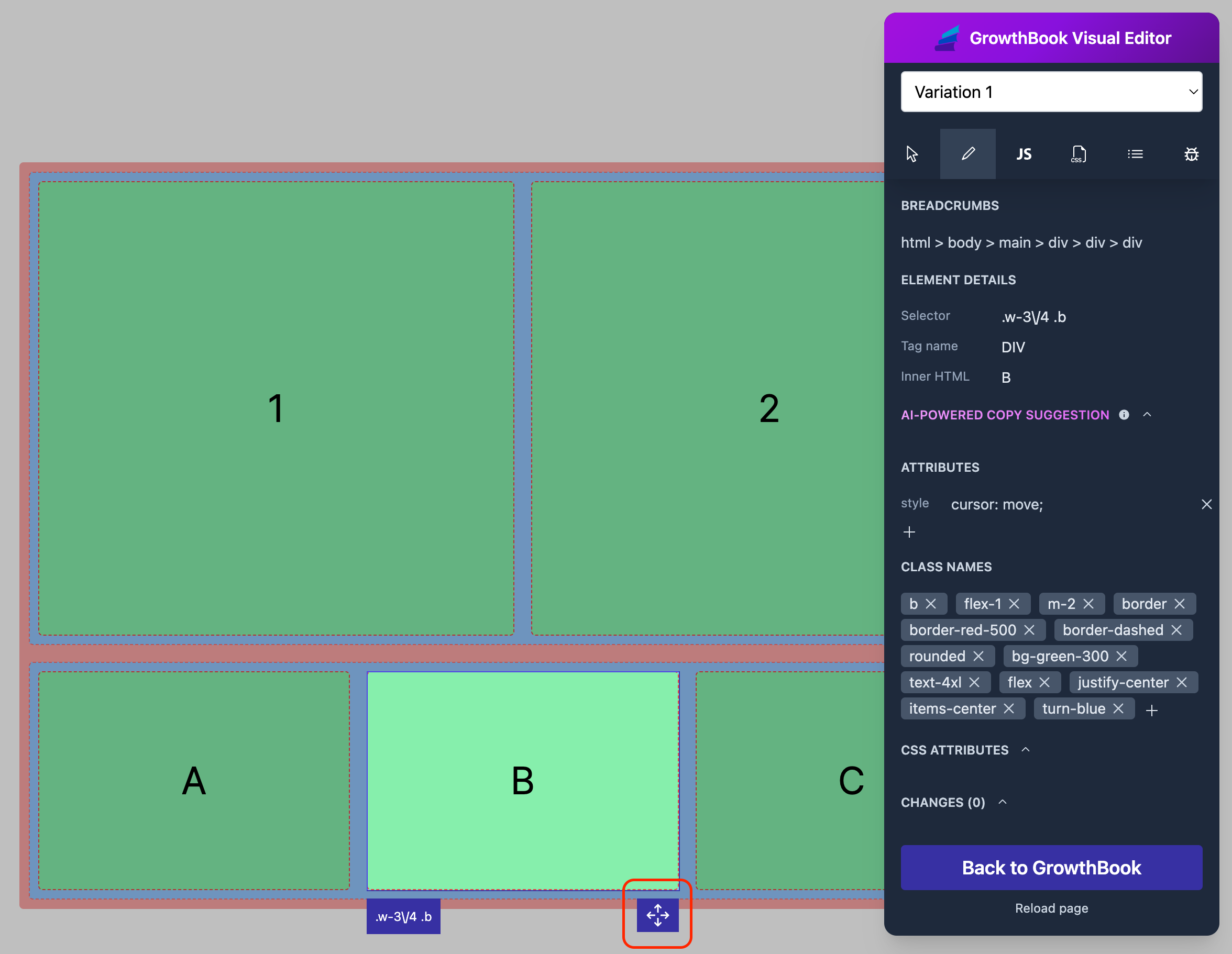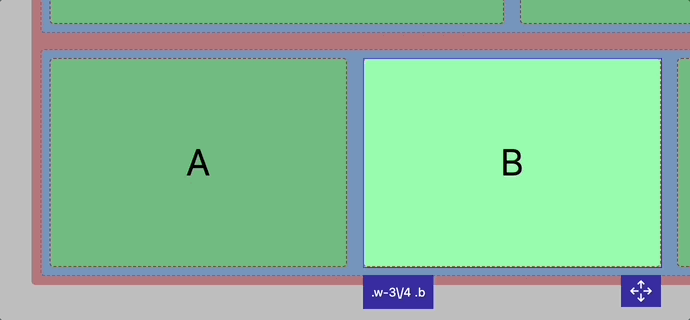Visual Editor
With the Visual Editor, users can design A/B tests on their site directly in their browser, run them in production, and analyze results, all without writing a single line of code. To use the Visual Editor, a software developer will need to integrate GrowthBook's Script Tag, JavaScript, or ReactJS SDKs with your application. Alternatively, use one of our Edge SDKs to render visual experiments on a CDN.
With client-side rendered apps (e.g., React, Vue, Svelte), the Visual Editor may not work optimally. Consider using Feature Flags instead for a better experience.
Requirements
All you need to get started is the GrowthBook DevTools browser extension installed on your Chrome or Firefox browser. Once you've added it to your browser, you need to add a Personal Access Token (GrowthBook menu).
The application you want to experiment on must be a front-end web application viewed in a browser. Our Visual Editor does not work for mobile apps (Native or ReactNative) or desktop apps (e.g. Electron). For unsupported platforms, we recommend using Feature Flags instead to implement your changes in code.
Allow Visual Experiments on the SDK Connection
Ensure that the "Include Visual Experiments" toggle is enabled in the SDK Connection's settings, otherwise visual experiments will not be sent to your application.
To check if visual experiments are enabled for your SDK connection in GrowthBook:
- Go to the Left navigation menu > SDK Configuration > SDK Connections page in the GrowthBook UI.
- Select the SDK connection in question.
- Click the purple "Edit" button in the upper right corner.
- Scroll down and look for the "Include Visual Experiments" toggle.
- If this toggle is enabled, visual experiments are included in the SDK payload and are enabled for the SDK.
- If it is disabled, visual experiments will not run and will not be sent to the application.
If you have enabled the toggle and still do not see visual experiments, double-check that you are using the correct client key and SDK connection in your application.
Creating a Visual Experiment
To use the visual editor, first add a new Experiment. This can be done under Experiments in the left nav.
Select the option to design a new experiment. Then, you'll have a series of fields to fill out (hypothesis, variation names, goal metrics, etc.). Don't worry, these can all be changed later.
Once you created an experiment, you should be prompted to open the Visual Editor. Make the desired visual changes using the editor. Once you've created your first experiment and are ready to deploy to production, there are some additional steps required (see Deploying to Production below).
URL Targeting
GrowthBook needs to know what page(s) of your site the experiment should run on.
For URL Targeting to work, you must pass the url targeting attribute into the GrowthBook SDK and also list it in the GrowthBook App.
See Targeting Attributes to learn more about targeting users with certain attributes.
If your experiment is going to be on a single static page, enter the full URL and submit (e.g. https://www.example.com/pricing).
If your experiment is going to be on a page with a dynamic URL (e.g. all pages that start with /post/), click on the "Advanced Mode" link.
You'll need to enter 2 different URLs.
- A single representative URL you want to load in the Visual Editor (e.g.
https://www.example.com/post/my-first-post) - A URL targeting pattern to match all of your dynamic URLs
The targeting pattern supports wildcards (*), so for this example, you could enter /post/*.
We recommend sticking with "Simple" URL targeting rules (don't be fooled by the name, it's actually really powerful). The other option (Regex) can be useful for really advanced use cases, but it is much harder to write and more error prone.
Simple Targeting
Our "simple" URL targeting option supports the vast majority of use cases and is easy to use. It supports the following features:
- Match based on full URLs (e.g.
https://www.example.com/pricing) - Match based on path (e.g.
/pricing) - Match based on query strings (e.g.
/pricing?utm_source=email) - Match based on hashes/anchors (e.g.
/pricing#more-info) - Wildcards (e.g.
/posts/*will match/posts/123AND/posts/2023/03/30/my-post) - Ignores leading and trailing slashes (e.g.
pricing,/pricing, and/pricing/are identical) - Ignores the protocol (e.g.
https://...will also matchhttp://...) - Ignores extra query string parameters (e.g.
/pricing/?plan=prowill match/pricing/?utm_source=email&plan=pro&logged-in=true)
Regex Targeting
Our "regex" URL targeting option supports full regular expressions. Writing regular expressions for URLs is very error prone, so be careful and make sure you escape all special characters you don't want to be interpreted. Here's a full example:
https?:\/\/(www\.)?example\.com\/pricing\/?
You can also match on just the path:
^\/pricing\/(pro|enterprise)
The Visual Editor
There are a number of different tools in the Visual Editor.

At the top is a dropdown where you can select which variation you are currently editing.
Below that is your toolbar. It has the following tools in order from left to right:
- Interactive Mode - Click around your site normally
- Selection Mode - Point and click to select an element on your site to edit. This is the most common way to make changes.
- Global CSS - Inject global CSS styles into the page. Use this to control things like page background color or font size.
- Custom JavaScript - Inject Javascript into the page. Use this to create complex variations.
- Change List - See a summary of all of the changes you've made to the page so far
When you're using the Element Selector, after you pick an element to edit, you'll be able to modify the Inner HTML (i.e. the copy), any attributes (e.g. a link HREF), and the list of CSS classes.
When you're finished making changes, click the Done Editing button to be taken back to GrowthBook.
Custom JavaScript
Custom JavaScript is executed as quickly as possible, often times before the page has fully loaded. This gives you the most flexibility in how to implement your experiment.
If you are making changes to elements on the page, make sure you wait until they exist. Below is a small helper function you can add to the top of your Custom JavaScript to help with this:
function waitFor(selector) {
return new Promise(resolve => {
const el = document.querySelector(selector);
if (el) return resolve(el);
const observer = new MutationObserver(() => {
const el = document.querySelector(selector);
if (el) { observer.disconnect(); resolve(el)}
});
observer.observe(document, {childList: true, subtree: true});
});
}
Then, you can use it like so:
waitFor(".my-element").then((el) => {
el.innerHTML = "Hello World!";
});
Drag and Drop
When in Selection Mode, you can select an element and click to drag and drop it positionally on the page.
Drag and Drop Handle
When an element is selected, you will see a floating handle to move it positionally. Alternatively, you can click anywhere on the selected element to move it as well.

Once dragging, the cursor will highlight an edge where the dragged element will land. When you release the cursor the element will move to the indicated spot. If you want to undo the move, click the 'Undo' button that is available for elements that have been dragged.

Debug Panel
The Visual Editor now comes with a Debug Panel to help diagnose any issues with your SDK configuration and URL Targeting rules. Use this to help diagnose your own errors, or provide a screenshot to our Support team when reaching out to help provide context.

Deploying to Production
Before you start your first experiment, you will first need to generate a Client Key in GrowthBook. You can get this by creating a new SDK Connection (under SDK Configuration in the left navigation).
Important: Make sure to enable the "Include Visual Experiments" toggle. If you forget this step, Visual Editor experiments will not be sent to your application.

You can also optionally include Draft Experiments (see below).
Once you create an SDK Connection, you need to follow the steps to integrate GrowthBook into your website.
The easiest and recommended way to do this is with our Script Tag SDK, which works out-of-the-box and doesn't require any configuration for most websites. It's also possible to use either our JavaScript or ReactJS SDKs, although these do require more up-front work to integrate into your application.
If you've already been using our front-end SDKs for feature flagging, make sure you:
- Update to the latest SDK version
- Follow the "Visual Editor" instructions in the SDK docs
Content Security Policy (CSP) Changes
If your website uses a Content Security Policy (CSP), there are some additional changes you'll need to make. This applies to both SDK and pre-build script tag integration.
script-src
Changing the script-src directive in your CSP is only required if you are writing custom JavaScript in the Visual Editor. If you are only changing styles or copy using the point-and-click editor, this is not required and you can skip this section.
If you have the script-src directive defined in your website's CSP, you'll need to enable 'unsafe-inline' and 'unsafe-eval' in order to leverage the Global JavaScript injection feature of the Visual Editor:
Content-Security-Policy: script-src 'self' 'unsafe-inline' 'unsafe-eval';
Using Script Nonces
As an alternative to allowing unsafe-inline, we support "nonces", although this requires some very technical and custom configuration to hook up.
First, you will need to generate a unique nonce value for every request and add it to your CSP header. This can be done on the edge such as with a Cloudflare Worker.
Then, you will need to pass this nonce into your GrowthBook SDK as jsInjectionNonce.
For example, if you are using our Script Tag SDK, you can add the following into your page's <head> BEFORE you load the GrowthBook snippet. Replace all instances of $NONCE with the unique nonce value you generated.
<script nonce="$NONCE">
window.growthbook_config = window.growthbook_config || {};
window.growthbook_config.jsInjectionNonce = "$NONCE";
</script>
You will still need to allow unsafe-eval.
Drafts and QA
While the experiment is still a draft, you can preview variations by adding a querystring to your URL.
To build the QA preview URL, you'll need the Experiment Id (viewable on the right side of the experiment page under Settings). You'll also need the variation number you want to preview. 0 is the control, 1 is the 1st variation, etc..
Now, just join these together with an equals sign (e.g. my-experiment-id=1). This needs to go in the Querystring part of the URL (after a question mark). Here's a full example:
https://www.example.com/pricing?my-experiment-id=1
Until an experiment is moved out of the "draft" phase and started, this is the only way to view it on your site.
Stopping an Experiment
When your experiment is finished, you can click on the Stop Experiment link at the top of results. This will prompt you for several bits of information about why you're stopping and what the conclusion was.
If your variation won, you can optionally enable a Temporary Rollout when stopping. This will continue running your experiment with the same targeting conditions, but send 100% of traffic to the winning variation and disable the trackingCallback from being called.
The reason it's called a "Temporary" Rollout is because you don't want to rely on our SDK to implement the winning variation forever. It's best practice to have your engineering team re-implement the changes directly in your site's code. This is for a number of reasons:
- Changes implemented in code are rendered quicker, so your site will load faster
- Changes in code will be picked up for SEO
- Changes applied through the visual editor require the SDK to download data from GrowthBook. Although lightweight, these stopped experiments can add up over time and further slow down your site.
- Reduce the chance of conflicts. If two visual editor experiments try to change the same element at the same time, it will not always work as expected. Moving the winning variation to code will avoid this issue.